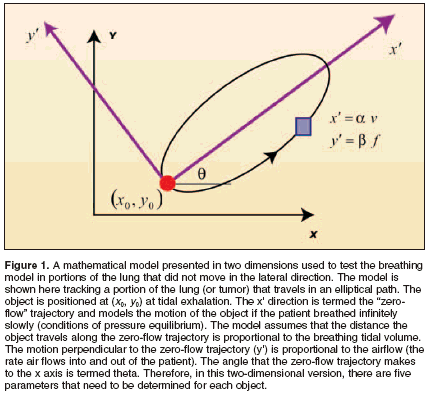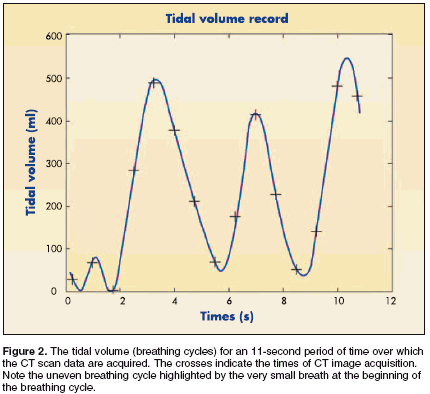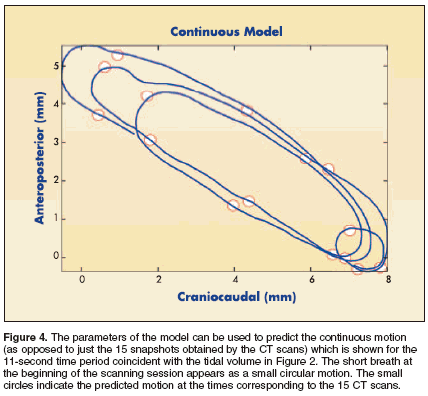New 5D Model May Predict Motion of Lung Tumors During Respiration
This special supplement to Oncology News International comprises expertcommentary and selected reports from the 2004 meetings of RSNA andASTRO about new imaging techniques, with a focus on state-of-the-art magneticresonance imaging, positron emission tomography, computed tomography,and complementary modalities for improving the diagnosis, staging, andtreatment of a variety of cancers. Evident in these reports is the increasingcollaboration between the specialties of radiation oncology and diagnosticradiology as imaging technology continues to evolve.
ST. LOUIS-A new 5-dimensional(5D) mathematical model seemsto accurately predict the motion oflung tumors on computed tomography(CT) scans obtained while patientsbreathe, according to a preliminaryreport presented at the 46thAnnual Meeting of the American Societyfor Therapeutic Radiology andOncology (ASTRO) (abstract 1050).Being able to quantitate the motionof internal organs and tumorsduring respiration would make it possibleto compensate for or counteractthe effects of breathing, thereby improvingthe accuracy of radiation treatmentplanning, Daniel A. Low, PhD,told Oncology News International inan interview."A method that modeled the motionas a function of a noninvasive externalmeasurement would be a valuable aidfor reducing the effective motion duringirradiation. For example, the linearaccelerator can be programmed toactivate only during a predeterminedphase of breathing, based on advancedtreatment planning optimizationtechniques," he explained.Limitations of 4D CTMost groups studying the motionof lung tumors view breathing as afunction of time (the fourth dimensionin 4D CT), which assumes thatbreathing is predictably cyclic and thattidal volume is the same from onebreath to the next, noted Dr. Low, anassociate professor of radiation oncologyat the Washington UniversitySchool of Medicine, St. Louis, Missouri."The reality is, [lung cancer patients'breathing] is absolutely notthat," he said. "These patients do notbreathe, for the most part, in little sinewaves. They have severe lung disease,independent of cancer, they have emphysema,and they have serious underlyingphysiologic damage causedby smoking ... they are not normalbreathers."


In addition, most radiation oncologygroups use coached breathing, inwhich patients are instructed when andhow to breathe during scanning. "Wehave very specifically avoided coachedbreathing because we want to understandhow well these models workwhen a patient is not concentrating onthe breathing process," Dr. Low said.Instead, patients are simply told not tomove during scanning.Developing the ModelThe investigators first assessed theperformance of a 4D CT process inwhich multislice CT scans were sorted(gated) by tidal volume. Each of 12patients with lung cancer underwent15 consecutive CT scans while spirometrymeasurements were obtained.The scans were sorted and reconstructedto create a 4D dataset. Analysesshowed near-perfect correlation betweentidal volume and the motion ofinternal objects, which was assessedfrom internal air content on the CTscan. In addition, the reconstructed4D dataset had high accuracy and highprecision (mean, 6%).They then developed a mathematicalbreathing-motion model based on5 dimensions-the spatial location ofthe object (x, y, and z) during a referencebreathing phase, tidal volume,and airflow (see Figure 1). To test themodel, they compared the actual positionsof 40 moving objects in thelung on CT scans obtained duringbreathing with the predicted positionsfrom the model (see Figures 2-4). Thiscomparison revealed "incredibly goodfits," Dr. Low said. The objects trackedmoved 4 to 11 mm during breathing,and the mean discrepancy betweenactual and predicted locations wasabout .5 mm.Although the model had been welltested in only one patient at the timeof the ASTRO meeting, its excellentperformance was especially noteworthybecause that patient had widelyranging tidal volumes, according toDr. Low. "This patient was not a regularbreather by any means. The patientbreathed little breaths, bigbreaths, medium breaths, and ourmodel just did not care. It did justfine," he said, noting that models thatassume constant tidal volume wouldhave been inaccurate by large margins.


Still, the findings using the newmodel must be viewed as preliminary,Dr. Low cautioned, noting that histeam is now rigorously testing themodel to see how it performs acrosspatients and sessions. "The clinicalapplications of this model are excitingfor radiation therapy. They may allowus to accurately determine if the tumormotion is small enough not torequire special treatment, or to providea treatment that fully accountsfor the motion," he concluded, addingthat he and his colleagues "plan onusing this technology to removebreathing motion artifacts from nuclearmedicine images." He noted thatthe model might also be useful in theassessment and management of patientswith other lung diseases, such asemphysema.